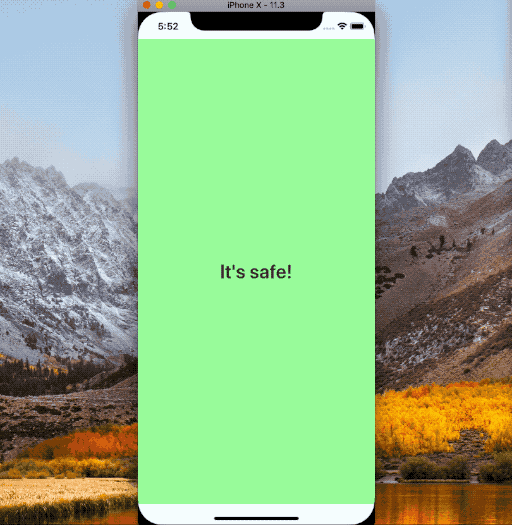
Security News
Vite Releases Technical Preview of Rolldown-Vite, a Rust-Based Bundler
Vite releases Rolldown-Vite, a Rust-based bundler preview offering faster builds and lower memory usage as a drop-in replacement for Vite.
react-native-safe-area
Advanced tools
React Native module to handle safe area insets natively for iOS 11 or later.

npmnpm install --save react-native-safe-area
You can link native code in the way you prefer:
Add line to your project target section in your Podfile:
+ pod 'react-native-safe-area', path: '../node_modules/react-native-safe-area'
Run command below:
react-native link react-native-safe-area
Use withSafeArea to apply safe area insets to views automatically.
import { withSafeArea } from 'react-native-safe-area'
A higher-order component which applies safe area insets automatically to the wrapped component.
component : Component - Wrapped component.applyTo : string - (Optional) Specify property to apply safe area insets.
margin - style.margin. (Default)padding - style.padding.absolutePosition - style.top, style.bottom, style.left and style.right.contentInset - contentInset and contentOffset for scroll views.direction : string - (Optional) Specify direction to apply safe area insets.
horizontal - Apply to left and right.vertical - Apply to top and bottom.both - horizontal + vertical. (Default)const SafeAreaView = withSafeArea(View, 'margin', 'both')
class App extends Component<{}> {
render() {
return (
<SafeAreaView>
<View />
</SafeAreaView>
)
}
}
const SafeAreaScrollView = withSafeArea(ScrollView, 'contentInset', 'vertical')
class App extends Component<{}> {
render() {
return (
<SafeAreaScrollView>
<View />
</SafeAreaScrollView>
)
}
}
You can also apply safe area insets to FlatList and SectionList.
wrappedRef : refReturns wrapped component's ref.
currentSafeAreaInsets : SafeAreaInsetsReturns current safe area insets.
import SafeArea from 'react-native-safe-area'
If you want to use SafeAreaInsets type, you can import it like below:
import SafeArea, { type SafeAreaInsets } from 'react-native-safe-area'
SafeArea.getSafeAreaInsetsForRootView()
.then((result) => {
console.log(result)
// { safeAreaInsets: { top: 44, left: 0, bottom: 34, right: 0 } }
})
class App extends Component<{}> {
// To keep the context of 'this'
onSafeAreaInsetsForRootViewChange = this.onSafeAreaInsetsForRootViewChange.bind(this)
componentDidMount() {
// Add event listener
SafeArea.addEventListener('safeAreaInsetsForRootViewDidChange', this.onSafeAreaInsetsForRootViewChange)
}
componentWillUnmount() {
// Remove event listener
SafeArea.removeEventListener('safeAreaInsetsForRootViewDidChange', this.onSafeAreaInsetsForRootViewChange)
}
onSafeAreaInsetsForRootViewChange(result) {
// Called every time that safe area insets changed
console.log(result)
// { safeAreaInsets: { top: 0, left: 44, bottom: 21, right: 44 } }
}
}
A simple example project is here.
FAQs
React Native module to get Safe Area Insets for iOS 11 or later
The npm package react-native-safe-area receives a total of 3,547 weekly downloads. As such, react-native-safe-area popularity was classified as popular.
We found that react-native-safe-area demonstrated a not healthy version release cadence and project activity because the last version was released a year ago. It has 1 open source maintainer collaborating on the project.
Did you know?

Socket for GitHub automatically highlights issues in each pull request and monitors the health of all your open source dependencies. Discover the contents of your packages and block harmful activity before you install or update your dependencies.

Security News
Vite releases Rolldown-Vite, a Rust-based bundler preview offering faster builds and lower memory usage as a drop-in replacement for Vite.

Research
Security News
A malicious npm typosquat uses remote commands to silently delete entire project directories after a single mistyped install.

Research
Security News
Malicious PyPI package semantic-types steals Solana private keys via transitive dependency installs using monkey patching and blockchain exfiltration.